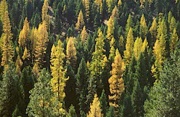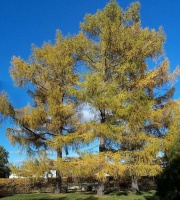Difference between revisions of "Larch"
(username removed) |
|||
| Line 2: | Line 2: | ||
== Description == | == Description == | ||
| − | Any of several deciduous conifer trees of the genus ''Larix'', most often found in the mountainous regions of southern and central Europe, North America and parts of Asia. The straight, tall, larch trees have short, needle-like leaves that turn yellow and drop in the fall. Larch wood is moderately heavy, durable and has a fine, uniform texture with a straight grain. While the wood is occasionally used for furniture, flooring, and cabinetry, it is more often used for telephone poles, posts, and railroad ties. The resin sap from larch trees is sold as [ | + | Any of several deciduous conifer trees of the genus ''Larix'', most often found in the mountainous regions of southern and central Europe, North America and parts of Asia. The straight, tall, larch trees have short, needle-like leaves that turn yellow and drop in the fall. Larch wood is moderately heavy, durable and has a fine, uniform texture with a straight grain. While the wood is occasionally used for furniture, flooring, and cabinetry, it is more often used for telephone poles, posts, and railroad ties. The resin sap from larch trees is sold as [[Venice turpentine]] and larch [[balsam]]. |
| − | See also [ | + | See also [[eastern tamarack]], and [[western larch]]. |
[[File:Siberianlarchvt.jpg|thumb|Siberian larch | [[File:Siberianlarchvt.jpg|thumb|Siberian larch | ||
''Larix sibirica'']] | ''Larix sibirica'']] | ||
| + | |||
== Synonyms and Related Terms == | == Synonyms and Related Terms == | ||
Revision as of 10:35, 21 January 2014
Description
Any of several deciduous conifer trees of the genus Larix, most often found in the mountainous regions of southern and central Europe, North America and parts of Asia. The straight, tall, larch trees have short, needle-like leaves that turn yellow and drop in the fall. Larch wood is moderately heavy, durable and has a fine, uniform texture with a straight grain. While the wood is occasionally used for furniture, flooring, and cabinetry, it is more often used for telephone poles, posts, and railroad ties. The resin sap from larch trees is sold as Venice turpentine and larch Balsam.
See also Eastern tamarack, and Western larch.
Synonyms and Related Terms
Larix; tamarack; hackmatack; Modřín (Ces.); Lærk (Dan.); Lärchen (Deut.); mélèze (Fr.); larici (It.); lariks (Ned.); modrzew (Pol.); larix (Port.); Lärkträd (Sven.); alerce (Esp.); laricio (Port.)
Other Properties
Heartwood is reddish brown. Annuals rings are distinct.
| Density | 30-40 ppcf |
|---|
Additional Information
Schoch, W., Heller, I., Schweingruber, F.H., Kienast, F., 2004:Wood anatomy of central European Species: European Larch,Larix decidua Mill.
Additional Images
Authority
- R. J. Gettens, G.L. Stout, Painting Materials, A Short Encyclopaedia, Dover Publications, New York, 1966
- F. H. Titmuss, Commercial Timbers of the World, The Technical Press Ltd., London, 1965 Comment: 30-40 ppcf
- Dictionary of Building Preservation, Ward Bucher, ed., John Wiley & Sons, Inc., New York City, 1996
- Encyclopedia Britannica, http://www.britannica.com Comment: "larch" Encyclopædia Britannica [Accessed October 18, 2001].
- Wikipedia, the free encyclopedia, at http://www.wikipedia.com Comment: http://en.wikipedia.org/wiki/Larch (Accessed Feb. 25, 2006)
- External source or communication Comment: Western Pine Association, Portland, Oregon: air-dry weight = 36 pcf
- Van Nostrand's Scientific Encyclopedia, Douglas M. Considine (ed.), Van Nostrand Reinhold, New York, 1976
- Random House, Webster's Encyclopedic Unabridged Dictionary of the English Language, Grammercy Book, New York, 1997
- The American Heritage Dictionary or Encarta, via Microsoft Bookshelf 98, Microsoft Corp., 1998
- CRC Handbook of Chemistry and Physics, Robert Weast (ed.), CRC Press, Boca Raton, Florida, v. 61, 1980 Comment: density=31-35 ppcf (0.50-0.56 g/cm3)


